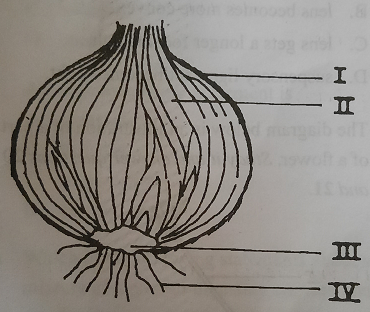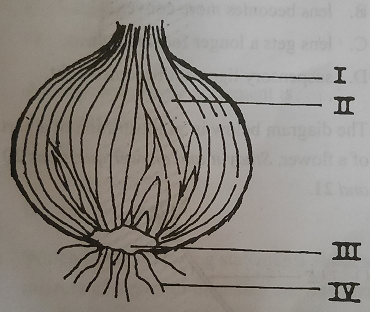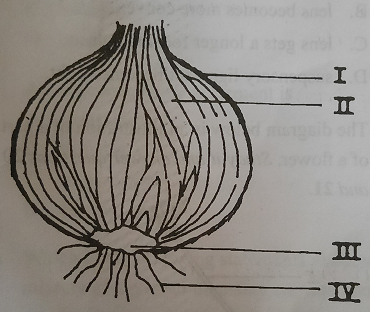Year :
2020
Title :
Biology
Exam :
WASSCE/WAEC MAY/JUNE
Paper 1 | Objectives
1 - 10 of 50 Questions
| # | Question | Ans |
|---|---|---|
| 1. |
The cell as the basic unit of life consists of A. cell wall and vacuole B. nucleus and cell wall C. cytoplasm and nucleus D. cytoplasm and vacuole |
C |
|
Use the following Classes of Arthropoda to answer the question below. |
||
| 2. |
Which members of the classes live mainly in an aquatic habitat? A. I B. II C. III D. IV |
A |
| 3. |
Which of the classes is characterized by the possession of two pairs of antennae? A. I B. II C. III D. IV |
A |
| 4. |
The organism with spiral chloroplasts and nucleus suspended by cytoplasmic strands is A. Volvox B. Spirogyra C. Paramecium D. Euglena Detailed SolutionSpirogyra is a filamentous charophyte green alga of the order Zygnematales, named for the helical or spiral arrangement of the chloroplasts that is characteristic of the genus. |
|
| 5. |
The network of double membrane that conveys materials through the cytoplasm is the A. plasma membrane B. nuclear membrane C. mitochondrion D. endoplasmic reticulum |
D |
| 6. |
 Food is stored in the part labeled A. stem tuber B. bulb C. stolon D. runner Detailed Solution- An onion bulb is a type of plant storage organ.- The bulbs are composed of shortened, compressed, underground stems surrounded by fleshy modified scale (leaves) that envelop a central bud at the tip of the stem. |
|
| 7. |
 The plant is a A. stem tuber B. bulb C. stolon D. runner |
B |
| 8. |
 The part labeled I is the A. apical bud B. scale leaf C. adventitious root D. fleshy leaf |
B |
| 9. |
Which of the following materials is not a living semi-permeable membrane? A. pig's bladder B. Unripe pawpaw fruit C. Yam tuber D. Sheet of cellophane |
|
| 10. |
In an experiment, mould and yeast cells were transferred into an environment with low oxygen concentration. After a few days, the mould dies while the yeast cells did not. Which of the following statements best explains the following observation. A. The yeast cells carried out photosynthesis while the mould did not B. Photosynthesis does not take place in the absence of oxygen C. Respiration can take place in yeast cells in the absence of oxygen D. Respiration does not occur in the mould |
C |
| 1. |
The cell as the basic unit of life consists of A. cell wall and vacuole B. nucleus and cell wall C. cytoplasm and nucleus D. cytoplasm and vacuole |
C |
|
Use the following Classes of Arthropoda to answer the question below. |
||
| 2. |
Which members of the classes live mainly in an aquatic habitat? A. I B. II C. III D. IV |
A |
| 3. |
Which of the classes is characterized by the possession of two pairs of antennae? A. I B. II C. III D. IV |
A |
| 4. |
The organism with spiral chloroplasts and nucleus suspended by cytoplasmic strands is A. Volvox B. Spirogyra C. Paramecium D. Euglena Detailed SolutionSpirogyra is a filamentous charophyte green alga of the order Zygnematales, named for the helical or spiral arrangement of the chloroplasts that is characteristic of the genus. |
|
| 5. |
The network of double membrane that conveys materials through the cytoplasm is the A. plasma membrane B. nuclear membrane C. mitochondrion D. endoplasmic reticulum |
D |
| 6. |
 Food is stored in the part labeled A. stem tuber B. bulb C. stolon D. runner Detailed Solution- An onion bulb is a type of plant storage organ.- The bulbs are composed of shortened, compressed, underground stems surrounded by fleshy modified scale (leaves) that envelop a central bud at the tip of the stem. |
|
| 7. |
 The plant is a A. stem tuber B. bulb C. stolon D. runner |
B |
| 8. |
 The part labeled I is the A. apical bud B. scale leaf C. adventitious root D. fleshy leaf |
B |
| 9. |
Which of the following materials is not a living semi-permeable membrane? A. pig's bladder B. Unripe pawpaw fruit C. Yam tuber D. Sheet of cellophane |
|
| 10. |
In an experiment, mould and yeast cells were transferred into an environment with low oxygen concentration. After a few days, the mould dies while the yeast cells did not. Which of the following statements best explains the following observation. A. The yeast cells carried out photosynthesis while the mould did not B. Photosynthesis does not take place in the absence of oxygen C. Respiration can take place in yeast cells in the absence of oxygen D. Respiration does not occur in the mould |
C |